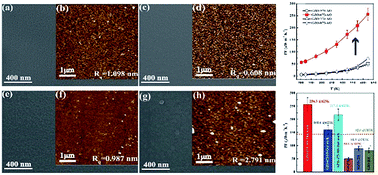Enhancing the thermoelectric performance of ZnO epitaxial films by Ga doping and thermal tuning†
Abstract
With good chemical and thermal stabilities, ZnO is a promising thermoelectric material that can be operated over a wide temperature range, particularly for high temperatures. For two dimensional (2D) thin films, modifying the thermal and electrical transport properties could be simplified due to the loss of one dimension. However, the carrier transport properties of pure ZnO have not yet been optimized. Herein, highly c-axis-orientated Ga-doped thin films have been epitaxially deposited at different temperatures, and the surface morphology and roughness have been modified. The GZO film deposited at 673 K exhibited an increased Hall mobility due to its high quality and crystallinity as well as higher carrier concentration due to enhanced Ga doping efficiency on Zn sites, resulting in its remarkable electrical conductivity. In addition, the enlarged effective mass, which could be mainly attributed to the enhancement in the density of states, allows the high retention of Seebeck coefficient value of GZO-673-AO upon increasing the carrier concentration. Ultimately, an improved power factor value of 256 μW m−1 K−2 at 623 K has been achieved for GZO-673-AO, demonstrating that Ga doping combined with optimized deposition temperatures could be a promising strategy for enhancing the thermoelectric properties of ZnO-based epitaxial films.



 Please wait while we load your content...
Please wait while we load your content...